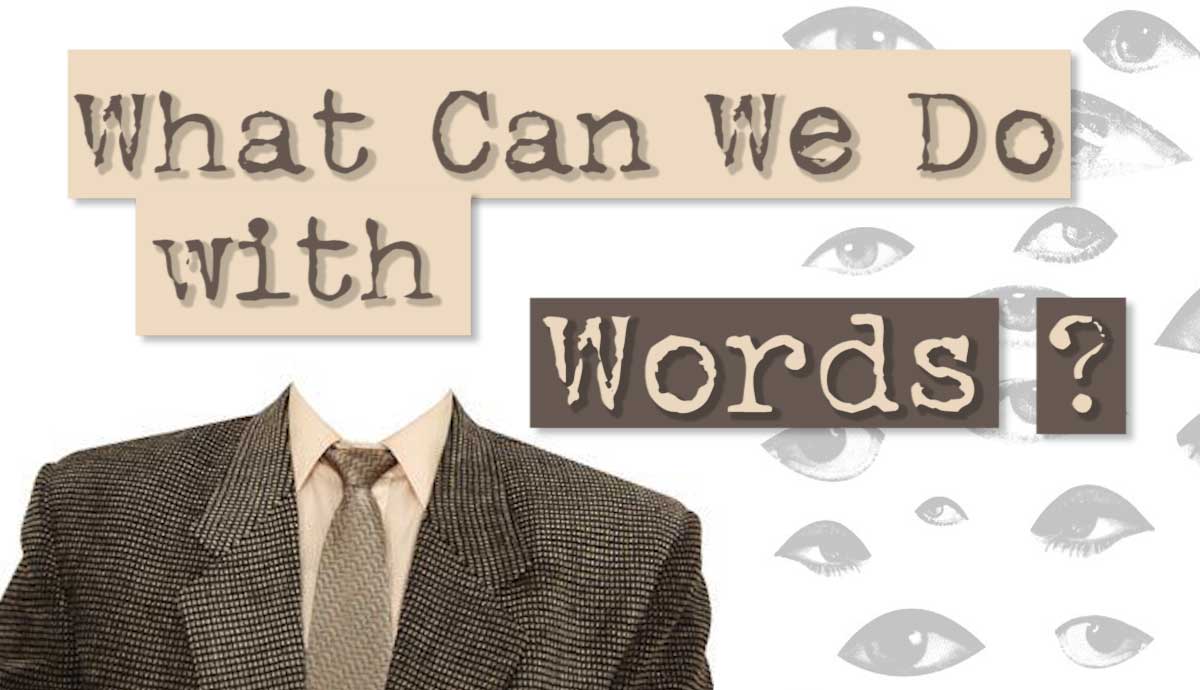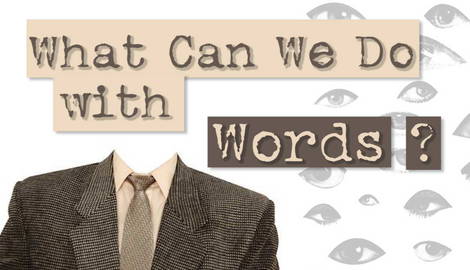
The average number of words we speak on a daily basis remains a contested matter. Some have argued that the average is around 16,000 words, while more modest researchers refer to 5,000. Of course, culture, sample size, and sociodemographic variables influence the answer. One thing is certainly true: the number of spoken words we use is not trivial. And this is without adding the number of text messages, tweets, and other written posts that are part of our habits.
What do we do with these words? Some are historically memorable, like those of US president Ronald Regan during a speech in West Berlin in 1987: “Mr. Gorbachev, tear down this wall!”. Others are kept as literature treasures, like those found in Shakespeare or Gabriel García Márquez. It seems clear that with words we do not only describe the world and refer to things, but we transform reality. This was the intuition that J. L. Austin, a British philosopher of language, explored during his Harvard lectures in 1995. His philosophy became greatly influential and constituted the beginning of Speech Act Theory.
The Origins of Speech Act Theory: J. L. Austin and Wittgenstein

Austin and the later Wittgenstein were interested in how we use language rather than speculating about its abstract nature. In the Philosophical Investigations, published posthumously in 1953, Wittgenstein observed that language was like a toolbox: hammers and screwdrivers are an analogy to the different functions words can have (2009, op. § 11). What type of functions/usages can we find?
The Austrian philosopher believed there is no such thing as a static list of usages. From giving orders and describing a state of affairs, to making jokes and promises, the usages are countless: “Countless different kinds of use of what we call ‘symbols’, ‘words’, and ‘sentences’.” (Wittgenstein, 2009, op. § 23a). The emphasis on “countless” (unzählige in German) means that one cannot simply make a taxonomy of usages; put differently, there are not easy to categorize.
Languages come into and go into existence. Some are born while others “become obsolete and forgotten” (Wittgenstein, 2009, op. § 23a). Historical linguists support this idea: it is only in historical practices that one finds the unfolding of language (Deutscher, 2006, p. 9 & 114). Contrary to Wittgenstein, J. L. Austin argued that classifying them could indeed be possible. That effort became the core of his Harvard lectures in 1995 from which Speech Act theory emerged.
What Are Speech Acts?

Austin made a provisional division between constative and performative sentences. While constative sentences had truth value (can be true or false), performatives were successful or not, or like Austin wrote, happy or unhappy (2020, p. 18).
Consider the sentence: ‘A water molecule is composed of two hydrogen atoms and one oxygen atom”. Clearly, this sentence is describing the world. It is stating a fact that can be true or false. But what fact is being described by Ronald Regan’s “Mr. Gorbachev, tear down this wall”? The second utterance is performative because it is neither true nor false. As a request, it could be either felicitous or infelicitous (another terminology for happy or unhappy). A request is felicitous when it changes the future such that the request is observed.
We can now define speech acts as, precisely, the act of uttering performative sentences. Later in his lectures, Austin realized that everything we say is, to various extents, performative, so he abandoned the distinction to develop a general theory of speech acts (Huang, 2014, p. 126). Austin introduced new distinctions to elucidate what is happening when someone says something: every utterance (locution) has an illocutionary act and a perlocutionary effect. Let us consider them quickly.
The Illocutionary and Perlocutionary Force of a Speech Act

The illocutionary act refers to the type of speech act that is being performed, this is, the function that the speaker intends to fulfill. The perlocutionary part, on the other hand, is the effect that an utterance could have on the hearer or addressee (Huang, 2014, p. 128).
As an illustration, recall that on December 8, 1941, the US Congress declared war on the Empire of Japan responding to the previous attack on Pearl Harbor. President Franklin D. Roosevelt addressed congress. In his discourse, one can distinguish illocutionary acts: promises (to the US) and warnings (to Japan), also including his requests for the state of war to be recognized.
We can speculate about the perlocutionary effects: some people were moved and excited, while others could have experienced fear and anxiety, as it was now clear that the United States would join World War II. The perlocutionary effect, therefore, does not depend on the intention of the speaker. I cannot say “I hereby scare you” or “I hereby convince you”.
Classifying Speech Acts

Focusing on the illocutionary act, J.L. Austin was ready to classify speech acts. He did this by using performative verbs that make the illocutionary act explicit (e.g., ‘I declare’, ‘I promise’). He ended up with six types: verdictives, exercitives, commissives, behabitives, and expositives (Austin, 2020, p. 166). The following table summarizes and explains his classification.
| Austin’s Speech Act Classification (2020, pp. 152 & ff) | ||
| Speech Act | Description | Example (explicit performatives) |
| Verdictives | Verdictives are those capable of truth value (what Austin initially called constative sentences). | Estimate, date, assess, describe, value. |
| Exercitives | Exercitives relate to decisions in favor or against a course of action. For example, Franklin D. Roosevelt’s request for the US congress to recognize the state of war. | Appoint, demote, veto, command, warn, pardon. |
| Commissives | A commissive commits the speaker to a certain course of action. | Promise, guarantee, vow, pledge oneself, contract, covenant. |
| Behabitives | These are reactions to other people’s behavior; they express an attitude toward someone else’s conduct. | Thank, apologize, deplore, congratulate, criticize, bless, curse, protest. |
| Expositives | Expositives are used to expound views and arguments. | Revise, understand, report, affirm, inform, deduce, conjecture, deny. |
John Searle’s Speech Act Theory

Austin’s classification of speech acts was closely examined and greatly improved by his student John Searle. In his book Expression and Meaning (1979), instead of focusing on performative verbs, he distinguishes twelve dimensions of variation in which illocutionary acts differ from one another. However, he decides to build his taxonomy mainly around two: the illocutionary point and the direction of fit (Searle, 1979, p. 5)1.
To begin, the illocutionary point is the purpose of the utterance. The illocutionary point of a description is different from, let us say, a command; but a request and a command have the same illocutionary point: “both are attempts to get the hearer to do something” (Searle, 1979, p. 3). Searle’s illocutionary point is part of Austin’s illocutionary act. In any case, there is something more that distinguishes illocutionary acts, namely, their direction of fit. To explain it Searle uses an example made by Elizabeth Anscombe.

Imagine that a husband goes to the grocery store with a list of things to buy. At the same time, he is being followed by a detective who is observing which products he is acquiring and writing them on a list as well. In the end, both the husband and the detective will have the same list (both contain the same items). Yet, they are different:
“In the case of the shopper’s list, the purpose of the list is, so to speak, to get the world to match the words; the man is supposed to make his actions fit the list. In the case of the detective, the purpose of the list is to make the words match the world; the man is supposed to make the list fit the actions of the shopper.”
(Searle, 1979, p. 3).
What Searle is stressing by using Anscombe’s example, is that speech acts (words) relate in different ways to reality (the world). Searle introduces a notation, such that ‘(↓)’ represents a word-to-world direction of fit (that of the detective), and ‘(↑)’ stands for a world-to-word direction of fit (that of the husband). Considering the illocutionary point and the direction of fit I can now summarize Searle’s taxonomy.
| Searle’s Speech Act Classification (1979) | |||
| Speech Act | Illocutionary Point | Direction of Fit | Examples |
| Assertives | To commit the speaker to something being the case (truth value) | (↓) | Assertions, statements, claims, hypothesis |
| Directives | Attempts by the speaker to get the hearer to do something | (↑) | Commands, requests, invitations |
| Commissives | Commit the speaker to some future course of action | (↑) | Promises, pledges, vows |
| Expressives | Express a psychological state | It is presupposed | Congratulations, apologies, condolences |
| Declarations | These speech acts, they create new states of affairs by representing them as being the case. | (↕) | Baptisms, marrying, hiring/firing, terminating a contract |

Searle is conscious of the additional requirement for non-linguistic institutions to exist so that ‘directive speech acts’ are successful (happy). A command, for example, is obeyed once the speaker is in a position of authority over the hearer (Searle, 1969, p. 66). This point was made in the Harvard Lectures as well (Austin, 2020, p. 18). In the case of ‘Expressives’ the direction of fit is presupposed because when one congratulates or expresses condolence there is already an antecedent speech act that is being assumed (Searle, 2010, p. 12).
For Searle, the most interesting speech acts are ‘Declarations”. Declarations bring about correspondence between the propositional content of an utterance and reality, this is, they create reality by representing it. In this sense when the proper authority in an appropriate context says “I declare you husband and wife” the content of that utterance is now real; this is why there is a double direction of fit (↕).
The Future of Speech Act Theory

Speech Act Theory is deeply influential in the modern philosophy of language, linguistics, social theory, Critical Theory, and discourse studies, among others. Some have tried to extend the classification of speech acts based on Searle (Ballmer & Brennenstuhl, 1981). The most challenging part about speech acts is, nevertheless, that they are not necessarily linguistic, this is, one can perform a speech act by gesture or by pointing at things. Additionally, some speech acts can be nested, such that the question ‘where is the salt?’ contains, in the context of dinner, a nested directive: ‘pass the salt’ or ‘please pass the salt’.
The most important idea to remember from speech act theory is this: in speaking we are not only describing things, but we are also performing actions and interacting with reality. We can commit ourselves to promises, we can influence the behavior of others, and we can choose to declare war.
Literature
Austin, J. L. (2020). How to do things with words (Kindle Ver). Barakaldo Books.
Ballmer, T., & Brennenstuhl, W. (1981). Speech Act Classification. Springer Verlag.
Deutscher, G. (2006). The Unfolding of Language. The evolution of mankind’s greatest invention. London: Arrow Books.
Huang, Y. (2014). Pragmatics (Second). Oxford University Press.
Searle, J. (1979). Expression and Meaning. Cambridge: Cambridge University Press.
Searle, J. (2010). Making the Social World. Oxford University Press.
Wittgenstein, L. (2009). Philosophical Investigations. (G. E. M. Anscombe, Ed.) (4th ed.). Oxford: Wiley Blackwell.
1 The third dimension is also relevant although we will not discuss it here: the expressed psychological state.










